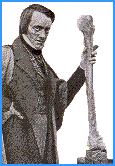Advertisement.
EnchantedLearning.com is a user-supported site.
As a bonus, site members have access to a banner-ad-free version of the site, with print-friendly pages.
Click here to learn more.
(Already a member? Click here.)
Click on an underlined word for more information on that subject.
If the dinosaur or paleontology term you are looking for is not in the dictionary, please e-mail us.
Sir Richard Owen
 Sir Richard Owen (1804-1892) was a pioneering British comparative anatomist who coined the term dinosauria (from the Greek "deinos" meaning fearfully great, and "sauros" meaning lizard), recognizing them as a suborder of large, extinct reptiles.
Sir Richard Owen (1804-1892) was a pioneering British comparative anatomist who coined the term dinosauria (from the Greek "deinos" meaning fearfully great, and "sauros" meaning lizard), recognizing them as a suborder of large, extinct reptiles.
He had noticed that a group of fossils (which included remains of Megalosaurus, Iguanodon, and Hylaeosaurus) had certain characteristics in common, including:
- Column-like legs
 (instead of the sprawling legs
(instead of the sprawling legs  that other reptiles have)
that other reptiles have)
- Five fused vertebrae fused to the pelvic girdle.
Owen proposed this new name in an article published in the "Proceedings of the British Association for the Advancement of Science" in 1842. In that article, Owen wrote, "The combination of such characters, some, as it were, from groups now distinct from each other, and all manifested by creatures far surpassing in size the largest of existing reptiles, will, it is presumed, be deemed sufficient ground for establishing a distinct tribe or suborder of Saurian Reptiles, for which I would propose the name of Dinosauria." (from Owen's "Report on British Fossil Reptiles." Part II. Report of the British Association for the Advancement of Science, Plymouth, England, 1842).
Owen presented dinosaurs as a separate taxonomic group in order to bolster his arguments against the newly proposed theory of evolution (although Darwin's "Origin of the Species" wasn't published until 1859, the basic ideas of evolution were known, but its mechanisms, including natural selection, were not). Ironically, his work actually helped support the evolutionists arguments.
Owen named and described the following dinosaurs: Anthodon (1876), Bothriospondylus (1875), Cardiodon (1841), Cetiosaurus (1841 - but Owen incorrectly thought that it was a kind of crocodile and not a dinosaur), Chondrosteosaurus (1876), Cimoliornis (1846), Cladeidon (1841), Coloborhynchus (1874), Dacentrurus (1875), Dinodocus (1884), Echinodon (1861), Massospondylus (1854), Nuthetes (1854), Polacanthus (1867), and Scelidosaurus (1859).
Owen also named Hyracotherium (Eohippus) in 1841; it is the earliest-known horse.
Enchanted Learning®
Over 35,000 Web Pages
Sample Pages for Prospective Subscribers, or click below
Click to read our Privacy Policy
Enchanted Learning Search
|
Search the Enchanted Learning website for:
|
Advertisement.
Advertisement.
Copyright ©1998-2018
EnchantedLearning.com ------ How to cite a web page

